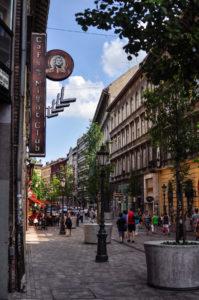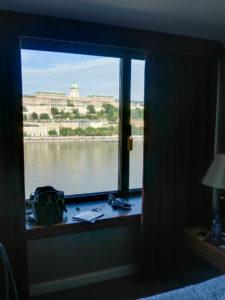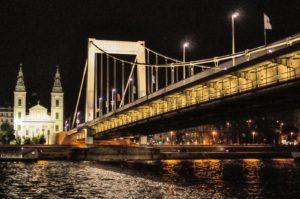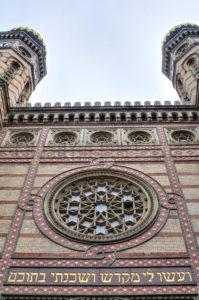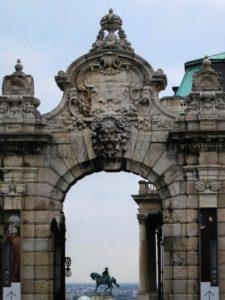I don't know a lot about the history of my own people let alone the history of pre-Medieval, Uralic-speaking tribes of Central Europe, but I do know a country of serious partiers when I see them. And when a city like Budapest Hungary spends almost its entire GNP on a single soirée, you totally want to stay friends with them.
The decorations are still up from Budapest Hungary's last party.
A hundred years ago or so, a bored Hungarian realized that the 1,000th anniversary of the Maygar's conquest over homelessness was coming up. Then someone suggested that a celebration was in order and everyone heartily agreed.
The Hungarian government spent the next decade or so “gussying up” the city of Budapest (pronounced “Boo-da-peshk”) to host it.
Okay, maybe “gussying up” is understating it a bit. Or understating it a lot, actually. The late 1800s was the country's Golden Age, so the government acted like they had been chosen to host the Olympics.
Flush with cash from somewhere, they basically “green lit” every crazy construction project that came across their desks. And then some (see also, City Park).

Budapest Hungary was the “Las Vegas” of Central Europe.
Starting around the 1870s, Budapest went on a construction spree that makes the one in modern-day China look like a worker's strike.
Among tons of other structures and parks, the Hungarian's erected the Parliament Building, St. Stephen's Basilica, Heroes' Square, and even Europe's first metro — it was nothing less than the total renovation of Hungary's biggest and best-known city. And their creations weren't boring concrete boxes or soul-crushing pavement parks (those would come later with the Commies), these buildings were works of art.
As we heard the story, the government insisted that 20% of every new construction budget had to go towards dressing up the building's facade, and it looks like it.
Architects went nuts with Art Nouveau, Baroque, Classical, Gothic Revival, Neo-Classical, Romanesque, Surrealism, or absolutely anything else their Pálinka-addled minds could think of. Now, Budapest really looks old, but not old in the “falling apart” sense, old in the “waaaaay overly ornate” sense.
Everywhere you look in Budapest Hungary, the buildings seem to be trying to out-fancify each other. And, considering that pyrotechnics and laser light-shows hadn't been invented yet, the architects nevertheless did a bang up job of showing off — clearly the Hungarian government wanted to make Budapest the “Las Vegas” of its time, and they succeeded in spades.
Yeah, but is Central Europe really proper Europe?
As a result of their decades-long millennium building bender, Budapest is today visually thick with “Europe-ocity.” Only the city of Porto crams more Europe-ocity into their city limits.
In fact, the city is so European-looking that, if you kidnapped an American — even someone from say, Mississippi where no one apparently ever leaves the country — and air-dropped them into the middle of Budapest, they would, without any assistance from anyone, most likely be able to guess that they were “somewhere in Epcot Center.” (Yeah, it's that realistic.)
Even though it's literally located within Europe and part of the European Union, Hungary is nonetheless situated waaaaaay out on the fringe of what I generally consider “real” Europe.
So I was skeptical that Budapest actually possessed the qualities that I feel make a city seem truly European — that indefinable “joie de vivre” which I believe translates roughly into “smug superiority and condescension.”
Disappointingly, Budapest Hungary didn't really have it. Instead, people were extremely nice and helpful which, frankly, took some getting used to.

When we flew into Budapest, for example, we were driven to our hotel by a large, congenial Hungarian who proudly told us about all the Hollywood movies that were shot in Budapest.
Over the course of our ride, he basically gave us a free Hungarian history lesson (none of which we can remember now), and frequently apologized for his “broken English” even though he spoke it better than the average American teen. The driver was so nice I got the feeling that he would've let us live with his family if we'd asked. Luckily for him, we'd already booked a hotel room.
Budapest Hungary is bisected by binary banks.
Instead, the gregarious driver dropped us off at the very nice Budapest Intercontinental Hotel — if you have to stay at a 4-star hotel in Budapest, the Intercontinental is surely one of them.
It's ideally located in “Pest V” (or District 5) right across the road from the famous Széchenyi Lánchíd or “Chain Bridge.” Our tour company managed to get us a Danube-view room, so we got a beautiful vista of Buda and the Bridge every morning which didn't suck very much at all.
The city of Budapest in Hungary was officially formed in 1873 by connecting “Buda” and “Pest” — two independent cities built on either side of the River Danube — via the Chain Bridge.
The Chain Bridge is famous for its chaininess.
The bridge was the first permanent “link” (get it?) between the hilly, residential area on the western bank (Buda), and the flat, commercial area on the eastern bank (Pest). Prior to the bridge's construction, the two peoples believed the other side of the river was just a mirage and never interacted with each other.
Since the two cities were joined, its approximately 1.8 million citizens wisely ordered the construction of four more bridges to prevent what would surely have been the world's most epic rush-hour traffic jam.
The four other bridges were: The Margaret Bridge, the Elizabeth Bridge, the Liberty (or Francis Joseph) Bridge, and the most recently constructed Megyeri Bridge. The Megyeri Bridge is known for being the longest bridge in Budapest but it's more famous for almost being named after Stephen Colbert. (So close, so close.)
The River Danube (or, as normal people call it, the Danube River) is the 2nd longest river in Europe. Originating in Germany's Black Forest, the river cuts through 10 cities, four capitals, and was memorialized in Johann Strauss II's famous “Blue Danube Waltz” (see also, 2001: A Space Odyssey).
This popular composition is proof that Strauss II either had horrible eyesight or a serious Pálinka-drinking problem because the River Danube has never been blue. Ever. Like ever. Seriously. You want to see blue water, try Bora Bora.
What we did in Buda (and/or Pest).
Immediately after unpacking, we left our hotel on foot and walked across the Chain Bridge to get some exercise after our 14-hour airborne sit-fest.
Since it was summer, Budapest was hot and humid even at night. So we thought better of climbing the hills of Buda and dying of heat prostration on our first day of vacation. Instead, we just walked along the River Danube and dodged fast-moving cyclists in the darkness instead.
While trying to find a way back over to the Pest side via the Elizabeth Bridge, we met a similarly confused, young British history professor. At first, we talked about unclear pedestrian signage, insufficient road lighting, fast-moving cars, and Hungarian emergency medical services.
Later chatting about places we'd been, he recommended we visit Poland and its insane “Wieliczka” salt caves. We assured him that it “sounded great” and then ran away the first opportunity we got.
Back on the Pest side of the Danube, we went looking for an authentic Hungarian meal. Luckily, a few semi-permanent restaurants were conveniently moored to the river docks right outside of our hotel.
So after reading a few good reviews for Vén Hajó Restaurant, we went in and polished off an order of Hungarian goulash, a goose liver trio, as well as a surprisingly good bottle of Hungarian white wine.
Everybody loves Budapest! (Unfortunately.)
Budapest is an incredible and beautiful city. So great that, at one time or another, pretty much everyone has taken a liking to the place: the Celts, Romans, Hungarians, Mongols, Ottomans, Austrians, Habsburgs, Romanians, Nazis, and the Soviets (twice!).
Every neighboring country that visited Budapest seemingly said, “Hey, it's really nice here, we should totally invade this place!” and then called in the tanks.
Hungarian Jews, in particular, had a rough go of all these “transitions.” The Hungarian government — initially on the Axis (bad) side during WWII — eventually saw the error of their way and tried to switch sides only to see the Nazis invade and get to work murdering about 600,000 Jews.
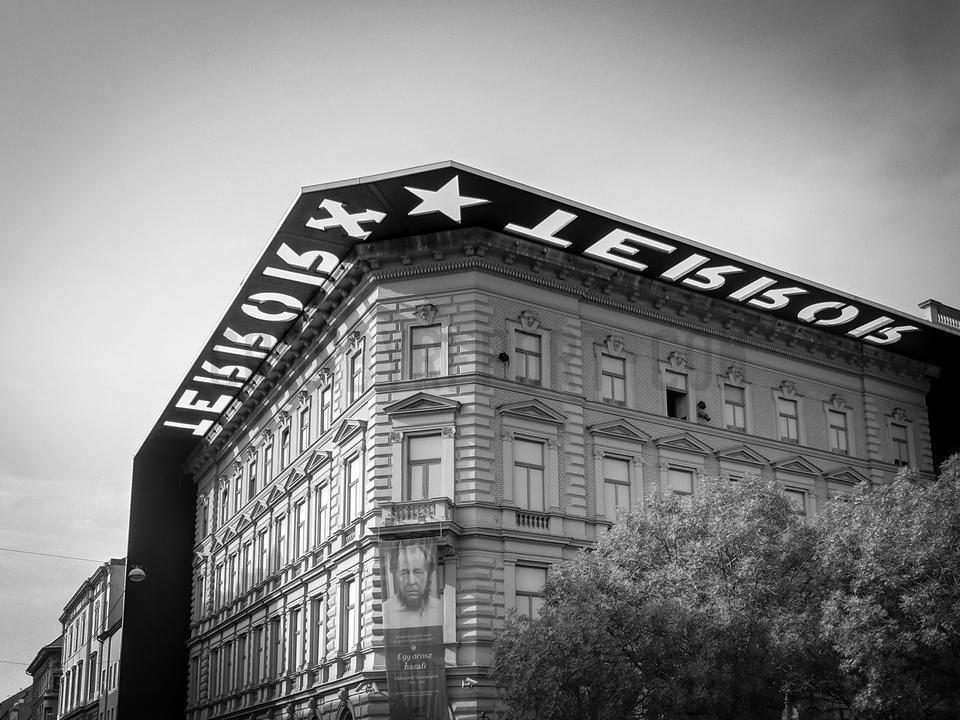
We toured the Raoul Wallenberg Memorial Park which commemorates those who protected many of Budapest's Jews from deportation to extermination camps [Error 404: Humor not found]. For more depressing facts, read about the Holocaust Memorial in Jerusalem.
The “Shoes on the Danube Bank” is a haunting memorial placed along the bank of the Danube where Nazi-wannabes, the Arrow Cross militiamen, would line up Jews and gun them down (see also, The Jewish Museum, House of Terror Museum, and the Great Synagogue). On a cheerier note, the Soviets caught and tried the Arrow Cross as war criminals…so there's that.
Budapest Hungary is more than just a castle, zoo, thermal spas, and a pond.
Central Budapest has a wacky 300-acre area creatively titled, “City Park,” which is, as the name pretty obviously implies, a city park. It too, like everything else in Budapest, was built for the 1896 Millennium Celebration.
But this city park isn't just a bunch of wide grassy areas and shady trees — no, it's a Michael Jackson wet dream.
The cornerstone highlight of the area is the Széchenyi (pronounced “say-cheney”) Medicinal Baths. The baths are really more like pools, only without any bacteria-killing chlorine. Europe's largest and hottest, these baths promise health-giving properties if you drink it (they even have it in a vending machine).
Yet, being infused with compounds like sulphate, calcium, magnesium, bicarbonate, fluoride and metabolic acids, the water really only guarantees you severe intestinal distress.
Another odd addition to the park is the bizarre Vajdahunyad Castle. Constructed for the Millennium Celebration out of cardboard (yes, cardboard), the castle was a jumble of different architectural styles, each intended to represent a different century.
The cardboard version proved so popular that it was eventually rebuilt out of brick, so it wouldn't keep melting every time it rained.
City Park also has a good-sized pond in the center — well, they call it a pond. During the summer months, people can rent boats and paddle around it, assuming it's not dried up. It's a bit like Central Park in New York City, only a lot weirder.
During the winter months, it becomes Central Europe's largest outdoor ice rink where people can skate around on it, assuming it's not dried up. Apparently, the city government of Budapest Hungary have trouble keeping water in the pond, so it may be more accurate to call it a crater.
Since no city park would be complete without an amusement park, Budapest has “one of the world's oldest roller coasters” (which sounds preferable to calling it the “world's deadliest,” I guess).
The park in Budapest Hungary also has a zoo, a zoological garden, and a transport museum full of planes, trains, and even a space capsule — who knew they had space travel back in 1896?! Very impressive.
Like most city parks in the rest of the world, this city park had a lot of statues, too. But the one that stood out most to me was the full-size, bronze likeness of Hungary's biggest hero, Ronald Reagan. Yes, that Ronald Reagan. The American actor who called his wife, “Mommy.” The dottering idiot who almost single-handedly ruined the United States. Yes, that guy.
They chose him not because of his fine and extensive acting career, but because he personally and single-handedly ended the Cold War. Clearly, without Mr. Reagan's bombastic speech, the Hungarians would've had to rely on the Soviet Union's crumbling economic and political structures to do the job.
Is there a “Cowards' Square” anywhere?

As a World Heritage Site, “Heroes' Square” is one of the world's oldest and largest flat, paved surfaces. But instead of using it as a mall parking lot, the Hungarians classed it up with a number of oxidizing statues and phallic-looking monuments to commemorate — you guessed it — the Millennium Celebrations.
Judging from what we'd seen in Budapest Hungary, 1896 must have been the last time the Hungarians did any new construction there.
Across the street from Heroes' Square, they erected the imposingly neoclassical Museum Of Fine Arts. Its prime location adjacent to the Square soon proved so popular that the museum attracted competitors including the conniving Budapest Palace Of Art with whom the Museum has a fierce rivalry to this very day — but don't Google that “fact.”
Hungarians don't put a lot of effort into naming their stuff.
Budapestians annoyingly name people using “directory style” (i.e., last name first, first name last). That means people like “Franz Ferdinand” are actually named Ferdinand Franz. I mean, what the hell? Right?! Come on!
Now, sure, this could be a “lost in translation” thing, but it seems to me that the Hungarians name things rather willy-nilly. For example, at the top of Buda there's an area named “Castle Hill” because — and I'm only guessing here — it's a hill with castles on it (“So what are we naming today? A castle on a hill? Let's call it ‘Castle Hill.' Everybody cool with that? Okay…NEEEEXXTT!”). They should really try a little harder in the future.
The people of Budapest Hungary realized hills were easier to defend.

In the 13th Century, the local people moved up the hill to cut down on being murdered so much by marauding Mongols. Presumably living longer as a result, the Budapestians went about building elaborate castles in Buda like…um, Buda Castle. (See what I'm saying about naming things…?) Over the centuries, Buda Castle was involved in a lot of battles and went through a lot of renovations, sometimes even by choice.
Another easily identifiable landmark in the heart of Buda's Castle District is the attractive St. Mattias Church, or The Church of Our Lady. First constructed in 1255, it got blowed up and rebuilt a lot, as well. Behind the St. Mattias Church is the more elaborate “Fisherman's Bastion,” so named because…sigh…a bunch of fishermen successfully defended the place in the Middle Ages.
Additional sights in the Castle District include the wordy Tower of the Church of Mary Magdalene, and the symbolically guarded Vienna Gate whose rigid guards you can totally sneak past. Curiously, a number of buildings in the area were badly shot up during World War II, but the Hungarians purposely didn't repair the bullet holes to always, and constantly, remind themselves and future generations that bullets can really mess up your walls.
The Pest side of Budapest has its charms, too.
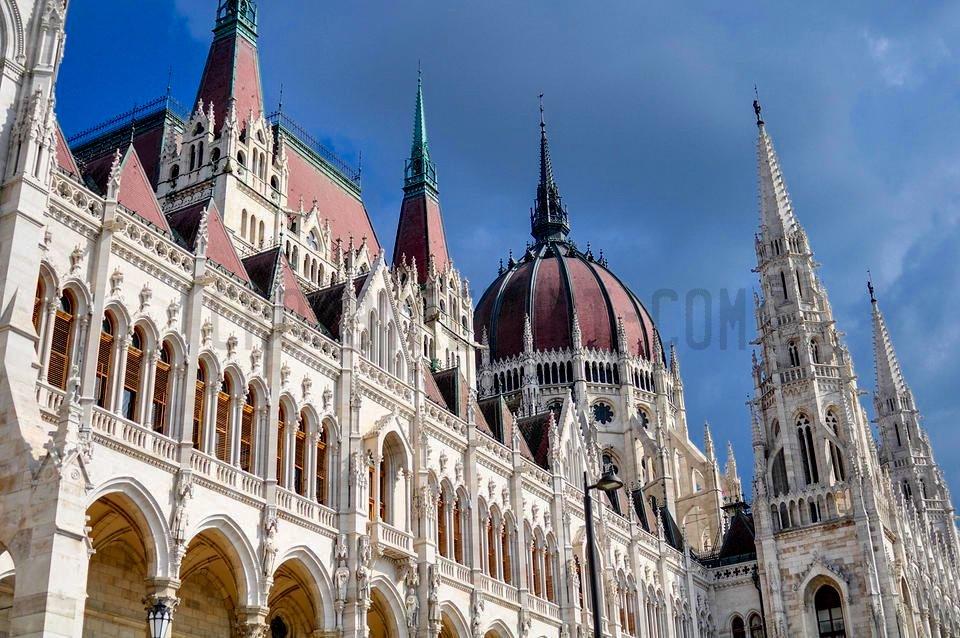
Closer to sea level in Pest, the locals built a bunch of nice looking places, too. One of the more flagrant examples of excess is the stunning Parliament Building. With ten courtyards, 691 rooms, and 65,616 feet of staircases, it's not just the largest parliamentary building in the world, it's also the pointiest. At night, it resembles the evil lair of an all-powerful super-villian who's mired in red tape and bureaucracy.
Another building worth seeing is the gold-plated, Neo-Renaissance State Opera House. It was commissioned by the Austria-Hungarian Emperor, Franz Joseph I, solely for the purpose of making Paris' and Vienna's opera houses look like disease-infested brothels.
The Hungarian Opera House took a decade to complete and is today considered amongst the finest in the world.
Its beauty and acoustics were so good that composer Franz Ritter von Liszt hung out there all the time. They eventually had to build a statue of him in one of the outside walls to get him to go home.
A building maybe not worth seeing is St. Steven's Basilica. Built in 1851, it's very pretty and all, but its claim to fame isn't its architecture. It's that St. Steven's severed and mummified right hand is kept there, locked inside in a gold box that visitors can view.
As my friends know, I'm not normally one to judge, but if you ask me, that's pretty damn freaky.
So, would I recommend going to Budapest Hungary?
If you're looking for a European vacation, but you're tired of being told that you're “murdering the French language” or that you should “stop eating with your hands,” then Budapest Hungary may be a good choice for you, too. It has all the things most people like about Europe — culture, art, and food — without any of the snooty condescension. Highly recommended.
Click here to see more of Peter Crosby's photography, including pics from his trip to Budapest, Hungary.





